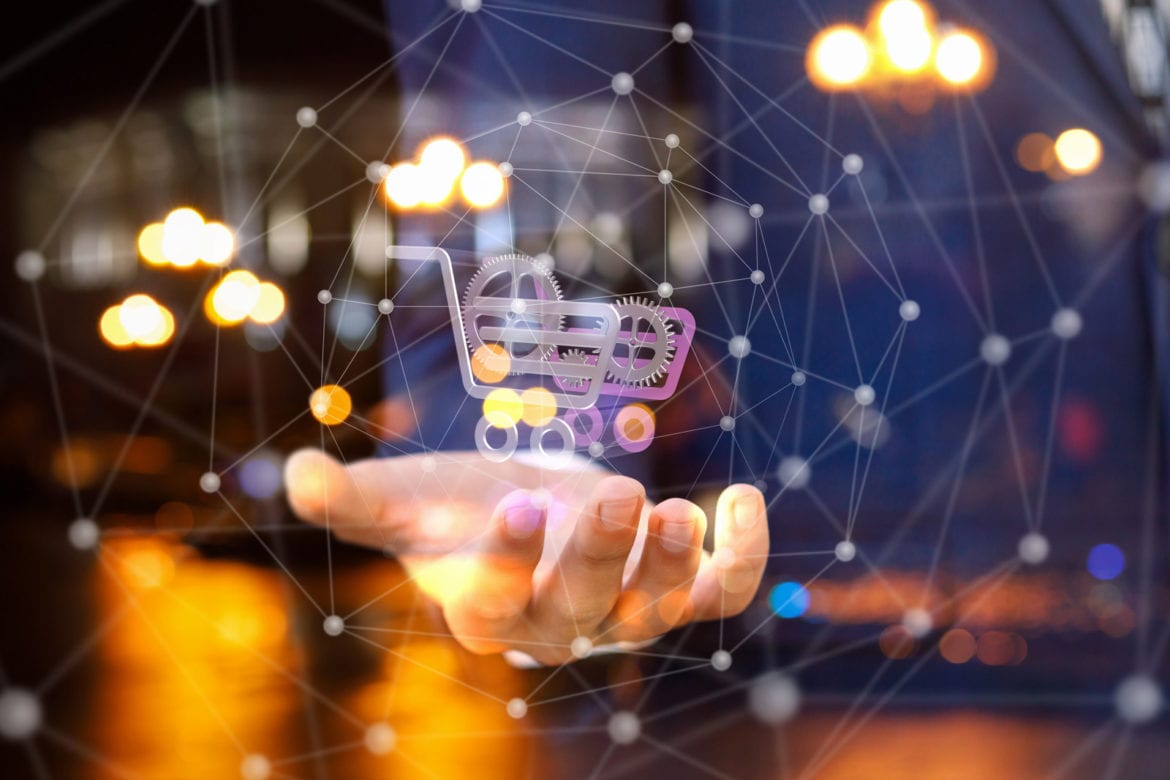|
Getting your Trinity Audio player ready...
|
This is an excerpt from our free-to-download report, eCommerce in Publishing: Trends & Strategies
In this final chapter we explore some of the biggest trends in eCommerce and their implications for publishers. These trends are already a consumer and technological reality, but they will only grow in prominence, as a result, publishers ignore them at their peril.
1. The Future Is Frictionless
As we noted in our previous eCommerce report, publishers, retailers and other interested parties (such as social networks) are focused on creating as seamless an eCommerce experience as possible.
Put simply, this means that consumers will be able to complete a purchase in the minimum number of steps possible. As Google explains, “a frictionless experience encompasses product organization, pricing and availability, navigation, ease of checkout, and payment.”
Reducing these points of friction increases conversion rates and reduces consumer frustration with the purchase process. Moreover, as Google further notes, we increasingly expect this type of functionality as standard.
“The pandemic has reinforced what brands and retailers should continue to focus on: enabling people to shop when they want, how they want, and where they want, all the while providing a pleasant and frictionless experience. Or, put another way, brands need to structure teams and budgets with an omnichannel mindset and focus on possible pain points.”
2. Shoppable Content
Building on the need for as frictionless an eCommerce experience as possible, one way that this is manifesting itself is through the growth of shoppable content. As Digiday observes, this appears to be “the next frontier for digital video advertising.”
Shoppable content is another pre-pandemic development that has only become more relevant and prominent, as eCommerce opportunities become more ubiquitous.
For print publishers, technological advances have made it possible for them to offer readers the opportunity to snap images with the camera on their phone and use this to then purchase products online.
In the first half of 2021 one of the first publishers to pioneer this, Bauer Media, partnered with image-recognition platform Phuzion Media to feature this service in Grazia and heat magazines. One key driver was that Bauer’s research found more than 1 in 3 people were reading magazines during the UK’s third lockdown, with 11% indicating they were reading more magazines than in the 12 months prior to the pandemic.
Bauer’s move stressed how this innovation removed the need for consumers to scan QR codes, the predominant means for previous shoppable content efforts.
The humble QR code, however, has not only had a resurgence during the pandemic, but it is also core to moves such as ShoppableTV service provided by NBCUniversal in the USA.
Prompted by an on-screen QR code, viewers can purchase an item seen during a show or the ad break. The company says its eCommerce conversion rates are 30% above the industry average.
The streaming platform Hulu is also investing in QR code-led shopping, and Amazon is testing a feature that enables viewers to make a purchase while watching an ad on IMDb TV (which they own), using Alexa or a Fire TV remote.
Shoppable video is not just the purview of TV networks and streaming providers.
Condé Nast has also integrated shoppable technology into its video content. “Shoppable series,” they noted in a press release, “include Vogue’s “7 Days 7 Looks” and “Beauty Secrets” and GQ’s “Grooming Gods,” each of which will give viewers the ability to instantly purchase the products showcased by their favourite celebrities, models and influencers.”
One reason for these developments is that “consumer behaviour has changed,” Evan Moore, vice president of commerce partnerships at NBCU, told eMarketer last year.
“Before, consumer behaviour was asynchronous, where you might see an advertisement and be inspired to consider or try a new brand. And then that was something that was lodged in your head, and you maybe acted on it weeks or months later while at the mall. Now any shopping attempt you have can be immediately acted on through either your mobile device or desktop while watching a TV program.”
As the Morning Brew newsletter put it, “Everything is QVC now.”
3. Social Commerce
Our ability to act on impulse, and in as frictionless a manner as possible, is also integral to social commerce, the ability to make online purchases within apps and social networks like Instagram, Pinterest and Facebook.
“Social commerce is what happens when savvy marketers take the best of e-commerce and combine it with social media,” Hootsuite says. In late-2020 they commented that “social commerce is a[n] $89.4 billion market right now. It’s projected to grow to $604.5 billion in the next seven years.”
This growth is driven by a myriad of factors, some technological, others more grounded in how we use these channels and their prevalence in our media habits.
After all, we spend a considerable amount of time on social networks. “The typical user actively uses or visits an average of 6.7 different social media platforms each month, and spends an average of close to 2½ hours using social media each day,” Kepios reveals.
Given this level of attention, it’s no surprise that platforms are seeking to monetize our engagement.
Within that, finding inspiration for things to buy, and finding products to purchase, are cited by more than a quarter of internet users worldwide as a main reason for using social media.
As a result, visual social networks like Pinterest and Instagram, alongside the brands and influencers on them, are increasingly exploring a broad range of eCommerce opportunities, and it’s a logical extension for users to be able to purchase the products that they have seen.
Shopping based tools and functionality can also be a differentiator for social networks.
Snapchat’s “Try It On” feature uses augmented reality (AR) to enable users to see how beauty or fashion products might look on them. How long before publishers, as standard, offer the same functionality for products that grace their (online or printed) pages?
NBCUniversal is also foraying into AR, having created a “Virtual Bravo Bazaar,” an augmented reality-driven website where fans can buy products associated with shows on its Bravo channel, including the “Below Deck” and “Real Housewives” franchises.
4. Live Shopping
App Annie’s recent ‘Evolution of Social Apps’ report estimates that “consumers will spend $6.78 billion via social apps this year – rising to $17.2 billion annually by 2025.”
Much of this stems from “gifting” content creators during live streams, as viewers “tip” their favourite streamers. But, alongside this, live shopping events on social networks are also significant drivers of traffic and consumer spending.
In China, 37% of online shoppers in China (265 million people) made purchases on live streams In 2019, TechCrunch reports, stressing “that was well before quarantine,” and the bump the pandemic has given eCommerce. In 2020, that number is estimated to have grown to around 560 million people.
Livestream shopping is also available on multiple Silicon Valley-based platforms too. Facebook, Instagram, TikTok and Pinterest among those exploring various opportunities to integrate this into their eCommerce strategies.
“If you were wondering why every app is looking to move into in-stream commerce, this is it,” says Social Media Today’s Andrew Hutchinson. “The data points to [a] significant opportunity for those platforms that can expand user engagement into direct spending and shopping behaviours, facilitating new revenue potential for the platforms, and new opportunities for brands.”
BuzzFeed has been an early adopter of this format. In the first half of 2021, they hosted more than 50 livestreams on Amazon Live, including a 16-hour-long broadcast on Amazon Prime Day in June. The broadcast generated over 1 million views on Amazon and Facebook Live, they told Digiday.
NBCUniversal worked with TikTok star Remi Bader to create an interactive livestream shopping show series over the recent Thanksgiving weekend.
Broadcast on Instagram and Facebook, the content was later rebroadcast on their Peacock streaming platform and the NBC App, with personalities from their Bravo TV channel making appearances on the shows.
5. New ways of paying for products
Publishers have experimented with the ability for audiences to purchase their content using methods like cryptocurrency (see, for example, Chicago Sun-Times, Time, Brainpickings), while POPSUGAR experimented with selling products via text.
In terms of current trends, publishers may also need to consider other developments such as the emerging practice of buy-now-pay-later (BNPL).
As Investopedia explains, this “is a type of short-term financing that allows consumers to make purchases and pay for them at a future date, often interest-free.” “If approved,” they add, “you make a small down payment, such as 25% of the overall purchase amount. You then pay off the remaining amount due in a series of interest-free instalments.”
Mastercard, PayPal and Shopify are among those offering these types of payments, as do a growing number of major retailers.
As this practice becomes engrained in our retail behaviours, so we can expect that publishers too will need to incorporate this into their eCommerce offerings.
In fact, some already do. And as a growing number of the third parties that publishers work with factor this into their services, we can expect this number to only increase.
Not surprisingly, some of the early adopters of this practice are among publishers for whom eCommerce is already a core part of their business.
At the end of last year, AdWeek pointed out how “publishers like BuzzFeed, and soon Bustle Digital Group, have taken deferred payment tech a step further, marrying the tech with their new onsite shopping capabilities.”
“When paired, publishers can replicate the experience of a contemporary retail website,” AdWeek wrote, “letting customers browse, add to their cart and use deferred payment to purchase items such as beauty products, cookware and clothing.”
Similarly, bringing many of these different emerging eCommerce elements together, Cosmopolitan Magazine partnered with a leading BNPL shopping and payments platform, Klarna, for a two-day virtual shopping event, Hauliday.
Specifically targetting Gen Z and millennials in the US, this was the second annual event, but the first to include a livestream shopping component.
As publishers expand their eCommerce offerings, they will increasingly need to partner with platforms, retailers and other service providers to ensure that they can offer the type of online shopping experiences that consumers are getting used to.
If they don’t, then they risk being left behind, and much of eCommerce’s potential for publishers will go unrealised.
As a result, publishers will need to factor in opportunities for onsite purchases, as well as being able to shop on social networks, integrating shoppable articles and videos, plus flexible payment options, into their architecture. These features will be essential if publishers want to be seen as bona fide retailers.
Ultimately, as Kate Robinson, svp of content distribution and partnerships at BDG explains, in a sentiment applicable to all of publishers’ eCommerce efforts: “If we want to compete against online retailers, we need to offer consumers the same experience and options as they do.”
This is an excerpt from our free-to-download report, eCommerce in Publishing: Trends & Strategies



